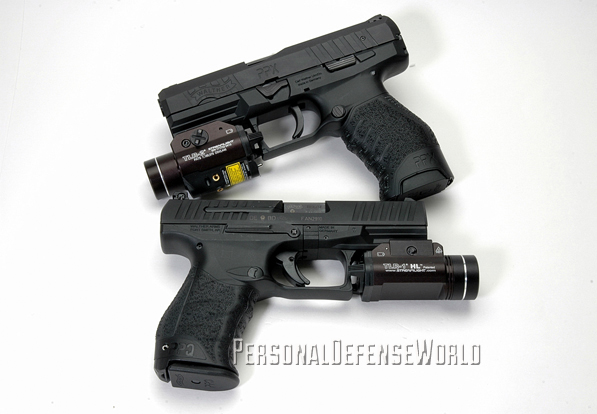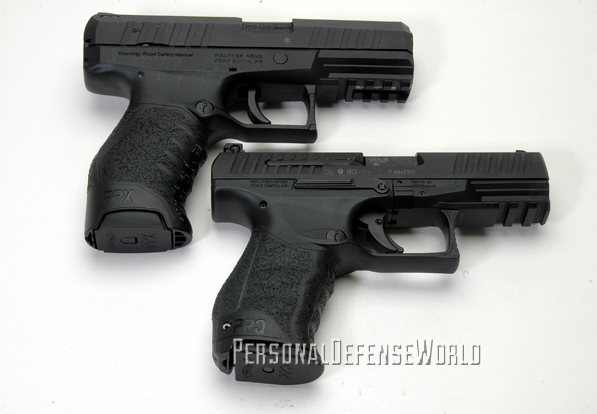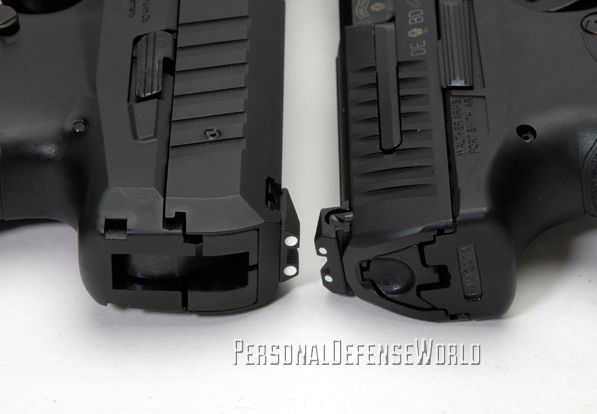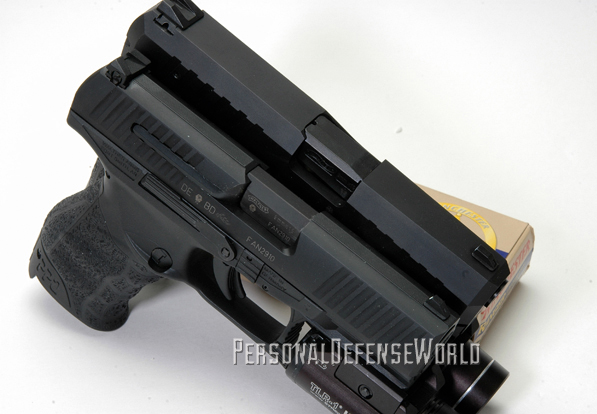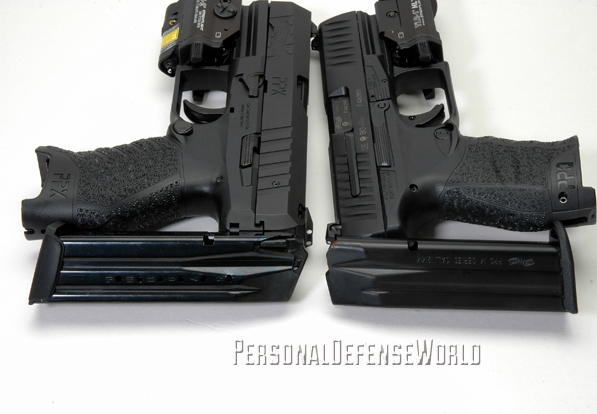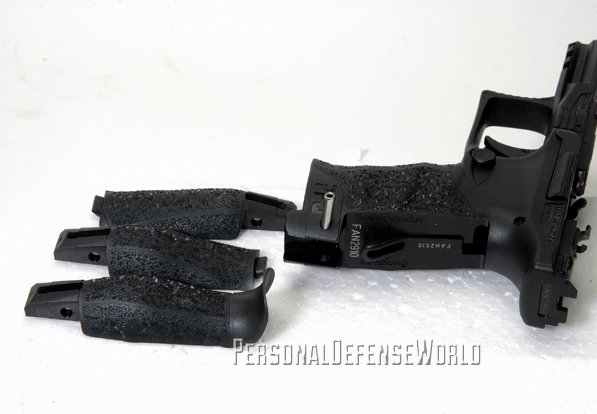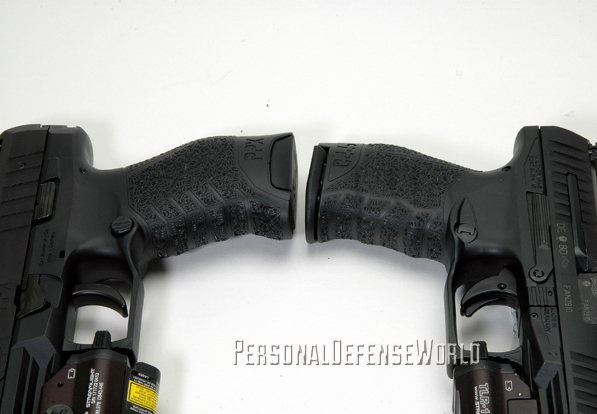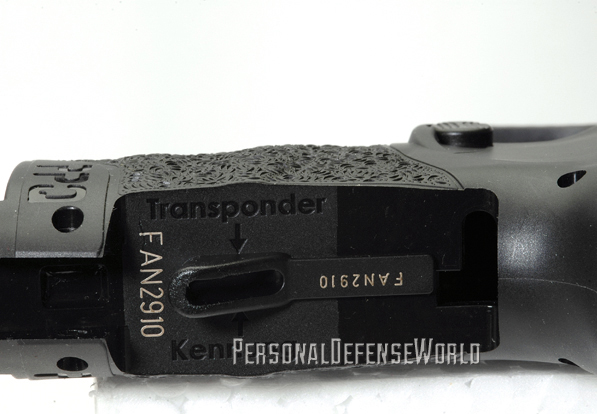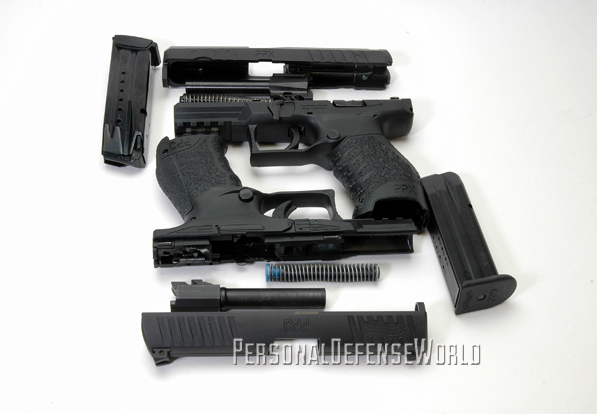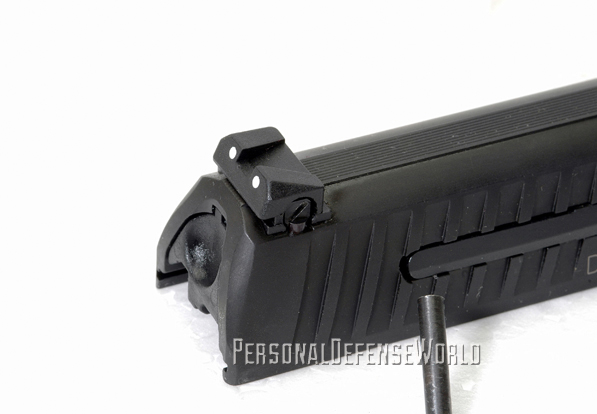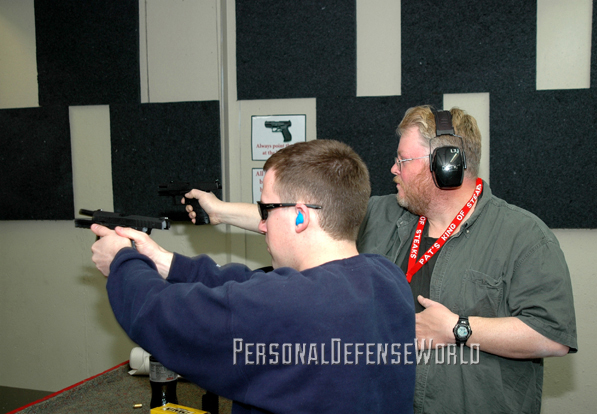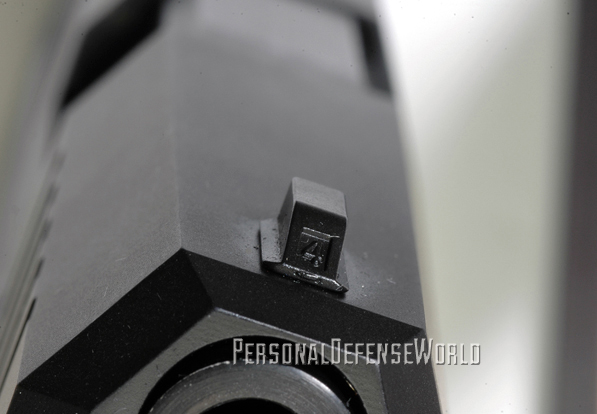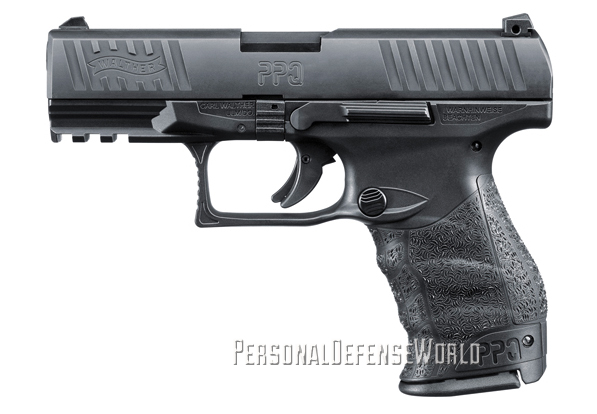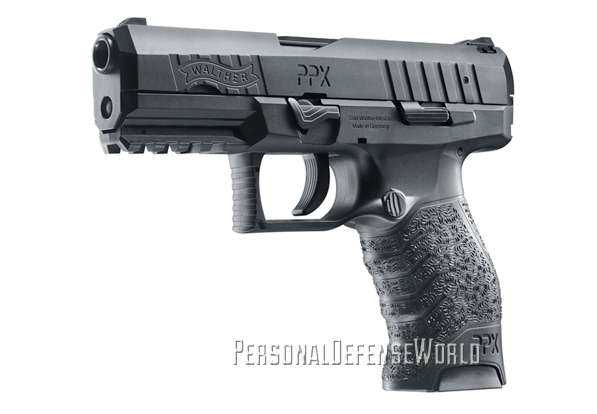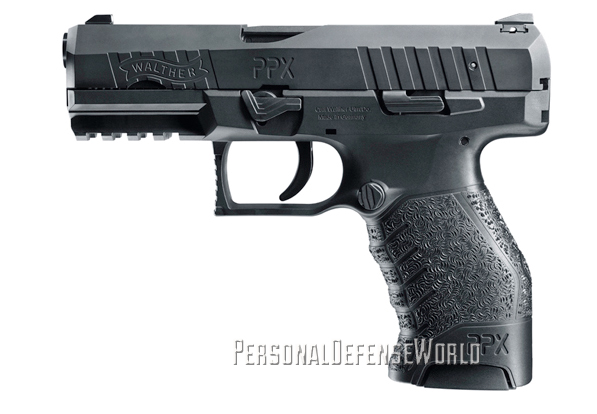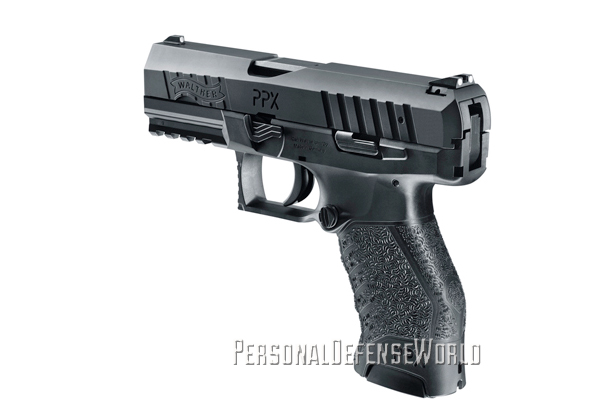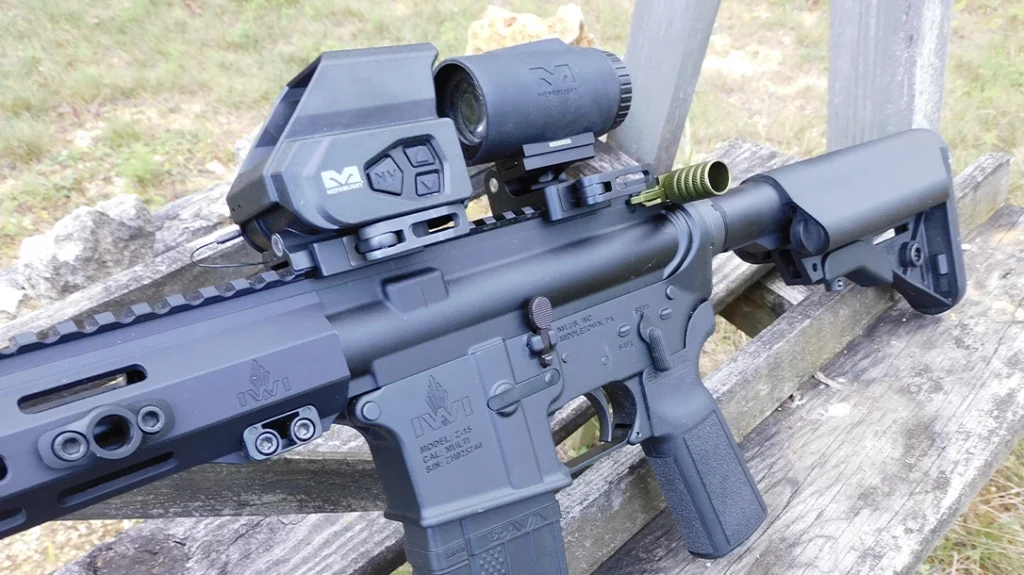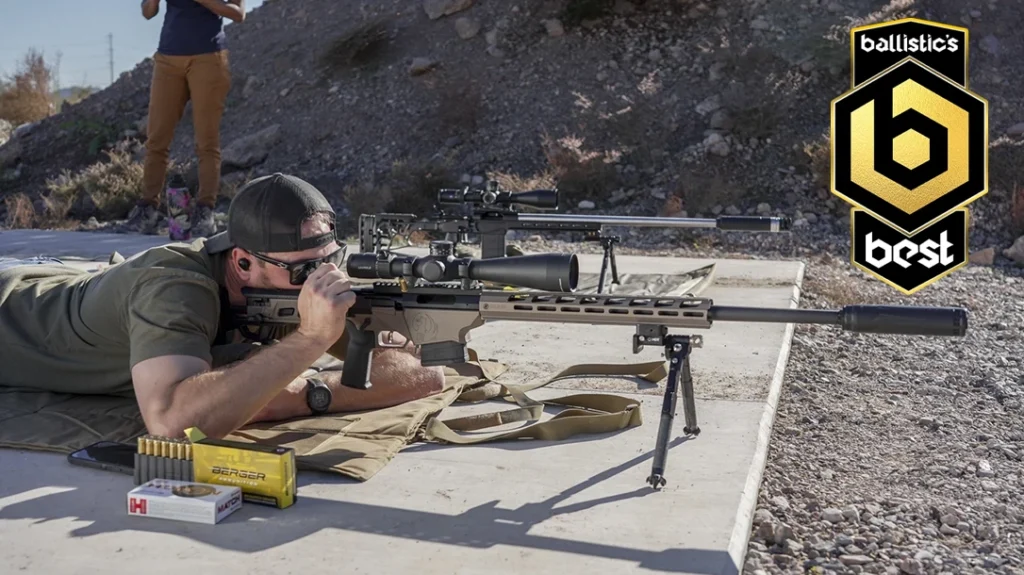Walther has two new polymer-frame pistols, the Walther PPQ M2 and the Walther PPX, both of which are offered in 9mm and .40 S&W chamberings. Upon first examination, the two appear to be quite similar in size, shape and finish, with only two apparent differences. Both are full-sized service pistols with steel slides and polymer frames. Both have three-dot sighting systems and Picatinny rails for accessories, along with steel magazines that have removable polymer basepads. Both are double-action-only (DAO), as retracting their slides pre-cocks the firing systems.
Their gripping areas share the same surface treatment. Both also strongly resemble the Walther P99 pistol. However, further examination and then shooting them disclosed their differences.
PPQ M2 Details
The PPQ M2 has a matte black finish, weighs 24 ounces unloaded and holds 15 rounds of 9mm ammunition. Its sights are polymer. The front sight is slightly ramped and grooved, and it is adjustable for elevation using substitute steel sights of various heights (optional purchase). A slotted screw makes changing this sight easy. The square-notch rear sight is adjustable for windage by drifting it in its retaining cut. Longitudinal grooves run between the marked three-dot sights.
Advertisement — Continue Reading Below
The slide tapers inward, nicely done by rounding the sides where they meet the slightly curved top. Two sets of widely spaced, diagonal grasping grooves are at the front and rear, aiding in slide manipu-lation. The slide contains the barrel and the captive recoil spring, which is mounted on a polymer guide rod. To make it easier to reassemble the pistol, the spring’s rear end cap is colored blue; the forward end cap is left black.
A sturdy, spring-loaded extractor is at the rear of the large ejection port, on the right side. This extractor also serves as a loaded-chamber indicator. When a round is chambered, its back end moves inward, exposing a red dot, thus providing visual and tactile indicators of a cartridge present in the barrel’s chamber. The pistol is serial-numbered on the slide and barrel and also at the top rear of the metal assembly, which contains the trigger and other parts of the operating system, and this is visible through a window in the frame.
A passive firing pin safety is slightly to the rear of the breech face. Worth noticing is the cartridge pick-up rail, which is stepped, with a narrow rail on the top right side of its larger body. I think this is done to help prevent the rail tip from striking a live primer when unloading or when clearing malfunctions. This thinner part is also beveled on its top and outboard area.
Advertisement — Continue Reading Below
The ample-sized and squared-off triggerguard has a horizontally grooved front face. The curved and smooth-faced trigger has an also-curved, pinned center lever that serves as one of the two drop safeties—the other being in the slide. This latter safety is moved by a projection on the trigger bar.
The dust cover has a Picatinny accessory mounting rail on which I easily installed and removed two Streamlight TLR-1 HL and TLR-2 lights. A long and ambidextrous slide stop is horizontally grooved over two-thirds of its length and is thumb-reachable for all but those with the smallest hands.
The takedown crossbar is on the frame, forward of the slide catch. The reversible magazine catch (see detailed instructions in the owner’s manual) has a grooved head and is at the left rear of the triggerguard, where it is partially protected from accidental depression by a molded ridge extending rearward on either side of the frame. This ridge can also serve as a thumb rest.
Advertisement — Continue Reading Below
The polymer frame has finger grooves on its frontstrap, and a rather unique combination of half-circle ridges and raised dots afford a solid but not “grabby” surface treatment in the normal gripping areas, including the inter-changeable backstrap. Three backstraps are included—sized small, medium and large—with the medium size pre-installed. While testing the pistol at the range, a fellow shooter mentioned that the shape of the medium backstrap allowed him to achieve a very high a grip on the PPQ M2. (The largest backstrap extends up to the top of the frame.)
To change backstraps, drive out the roll pin at the lower rear of the grip with a roll pin punch. The backstraps are notched at their bottom rear to accommodate this retaining pin, which can be used to attach a lanyard. The overhang of the backstrap also aids in inserting a magazine.
Interestingly, with the backstrap insert removed, you will find a raised slot on the inner wall of the frame. Marked on the left side of this slot is “transponder” and on the right side is “kennung,” which translates to “identifier.” It appears to be for holding electronic media.
Advertisement — Continue Reading Below
The PPQ M2 comes with two metal-body, 15-round magazines with orange polymer followers and removable, black polymer baseplates, along with a sturdy magazine loader. Cartridge witness holes, numbered from “4” to “15,” are on the
rear walls of the magazine bodies.
PPX Details
The PPX also has a blackened steel slide and a polymer frame. It weighs 27.2 ounces unloaded. The slide and barrel are Tenifer coated. Two all-steel, 16-round magazines are furnished with the PPX, and they also include removable, polymer basepads. The polymer followers are also black in color. Note, however, that the magazines for both pistols are not interchangeable.
The angular slide contains the barrel and captive recoil spring, and here the retaining end caps are both black. The PPX has diagonal grasping grooves similar to the PPQ M2’s, and for targeting, it features a fixed front sight and an adjustable rear in a three-dot configuration. The large internal extractor is at the lower right side of its large ejection port. A passive firing pin drop safety is utilized, as is a spring-driven firing striker. The barrel’s chamber hood is notched at its center rear to serve as a loaded-chamber indicator.
Advertisement — Continue Reading Below
The PPX frame is also shaped like the PPQ M2’s, with the same surface treatment and a similarly constructed magazine catch, which is partially protected from accidental release by a molded ridge in the frame. The catch only appears to differ in that its top area is serrated vertically, not horizontally. The dust cover also features a Picatinny rail.
But there are several differences be-tween the PPX and PPQ M2. The PPX’s grip area is 0.3 inches longer, which means most shooters should be able to obtain a full grip, and the frontstrap finger grooves do not continue onto the sides of the grip, as they do on the PPQ M2. You can also obtain a higher shooting grip with the PPX. The curved trigger has shallow grooves and is positioned about 40 percent of the way forward in the ample and squared triggerguard, which has a horizontally grooved forward face. There is no trigger drop lever in the face of the trigger.
An external and bobbed hammer is positioned forward and rests within a cutout in the rear of the slide. The hammer cannot be manually cocked, and it does not visibly cock when the slide is cycled. Instead, it rides with the moving slide. Pressing the trigger fully raises and releases the hammer, which in turn strikes the rear of the striker, firing the pistol. The disassembly lever is on the left side of the frame, forward of the triggerguard, unlike the PPQ M2’s.
Advertisement — Continue Reading Below
The PPX’s trigger pull is heavier at 6.5 pounds, as compared to 5.5 pounds for the PPQ M2. This is perhaps due to the PPX lacking a trigger drop safety. Having a heavier trigger spring helps keep the trigger from moving due to inertia if the pistol is dropped from a significant height. While the PPX’s trigger pull is fairly light, it is not as nice as the PPQ M2’s trigger, as the former has a noticeable amount of creep, but you’ll only notice it with a slow trigger press. The trigger reset, however, is about as good as the PPQ M2’s.
Rounds Downrange
Both pistols are capable of great accuracy—they’re only limited by a shooter’s skill and the quality of ammunition. At the range, my fellow shooters and I agreed that both pistols lack any annoying sharp edges and are simple to operate while maintaining a firm grip on them. We also agreed that the PPQ M2’s “feel” is second to none. This feeling is well-stated by a comment from one of the shooters, who said, “My hand seems to naturally take a good shooting grip.” Another “tell” was that no one asked to try the other grip inserts; the pistol came with a medium-sized insert installed.
Advertisement — Continue Reading Below
Also, we all agreed that the trigger of the PPQ M2 is the best we have experienced on a stock, striker-fired pis-
tol right out of the box, with no lubrication added before, during or after. Note that my shooting partners are classified as “Masters” in action-shooting comp-etitions, and they also help shoot all of the competitors’ pistols over a chronograph to make sure the ammunition is compliant with the rules. In short, they’ve shot a bunch of guns using a controlled and deliberate process.
My associates weren’t quite as impressed with the PPX’s trigger pull, but I think it suffered by comparison because we
had started the day with the PPQ M2, which, as noted earlier, has an outstanding trigger pull. We were spoiled. On another range day I shot the PPX some more, leaving the “spoiler” at home. Now, its trigger pull felt quite good.
As far as any further comparisons of the two, it’s difficult. The short, light trigger pull and natural-feeling grip of the PPQ M2 are definite winners, but there are very reasonable arguments made for having a heavier trigger pull. The PPX has a very good trigger, and its longer grip may be a plus for the reasons already mentioned. The PPQ M2 has an MSRP ranging from $599 to $699, and the PPX comes with an MSRP of $449 to $499. It’s a tough choice when both pistols are this nice! For more information, visit waltherarms.com or call 479-242-8500.
Advertisement — Continue Reading Below
BUY NOW! AT www.personaldefenseworld.com/subscribe/handguns-buyers-guide/.
